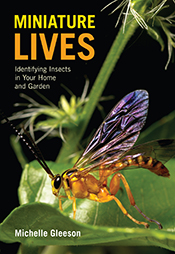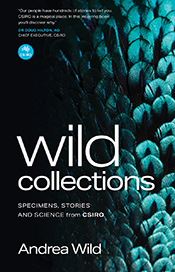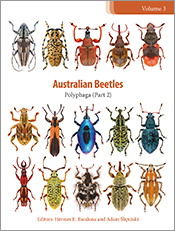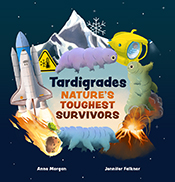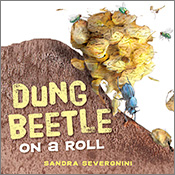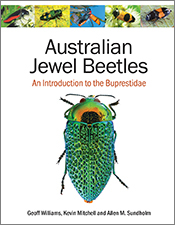Miniature Lives
Identifying Insects in Your Home and Garden
By: Michelle GleesonAn easy-to-use identification guide to Australian insects in your home and garden.
We can’t avoid insects. They scurry past us in the kitchen, pop up in our gardens, or are presented to us in jars by inquisitive children. Despite encountering them on a daily basis, most people don’t know an aphid from an antlion, and identifying an insect using field guides or internet searches can be daunting. + Full description
Miniature Lives provides a range of simple strategies that people can use to identify and learn more about the insects in their homes and gardens. Featuring a step-by-step, illustrated identification key and detailed illustrations and colour photographs, the book guides the reader through the basics of entomology (the study of insects). Simple explanations, amusing analogies and quirky facts describe where insects live, how they grow and protect themselves, the clues they leave behind and their status as friend or foe in a way that is both interesting and easy to understand.
Gardeners, nature lovers, students, teachers, and parents and grandparents of bug-crazed kids will love this comprehensive guide to the marvellous diversity of insects that surrounds us and the miniature lives they lead.
- Short descriptionReviews
"This is another beautifully produced book from CSIRO Publishing.
"It deserves a place on the bookshelf next to the bird-book, but it would also make a great gift to a young enthusiast."
Nick Goldie, Cooma-Monaro Express, 31/3/16
"the strength of the book lies with the section about insect orders - full of impressive images and wonderful facts. Definitely a book for all school kids, teachers, parents and avid gardeners."
Paul Plant, subTropical Gardening Magazine, Issue 41, June 2016, p. 84
"Easy reading, a pleasing layout and a touch of humour are what make this guide to identifying Australian garden insects a treat for the budding entomologist, gardening enthusiast, or child with an interest in our backyard bugs."
Rachel Fetherston, Wild Melbourne blog, 24/5/16
"Fun and informative - what more could you ask?"
Ian Fraser, Natural History Book Reviews, 22, July 2016
"the book is easy to understand and written for everyone who is interested in everyday insects, including children! ... [The book has] great detailed drawings and pictures and lots of information about insects and bugs."
Sophie Scott (8 years old), Growing Australian, September 2016, p. 13
"Well set out, beautifully photographed and with an illustrated identification key... I couldn't agree more with the wonderful sentiments of Densey Clyne who penned the Foreword. "This book is set to fill an important role, not least in the cause of insect conservation. It will serve as a useful reference work for the serious field entomologist. And hopefully it will help to shatter old prejudices as it introduces new generations to the diverse, secretive, often beautiful and always intriguing minibeasts whose world we so recently came to share.""
Jill Fechner, Metamorphosis Australia (Newsletter of the BOIC), 2016
"Although this guide will undoubtedly be helpful for Australians... Almost without exception, the images provided were recognizable to family, and the characters given for higher-level identification were suitable for use in North and South America... this manual should be valuable nearly anywhere. In particular, students who are struggling to make an insect collection for an introductory entomology course, and laboring with a dense dichotomous key, will find this book to be very helpful. I recommend that a copy be available to beginning students in their laboratory. I suspect that beginning instructors and teaching assistants will also find this book to provide a practical approach to identification, and therefore to be a handy reference."
John L. Capinera, Florida Entomologist 99(4), 2016
Details
Paperback | March 2016 | $ 49.99ISBN: 9781486301379 | 344 pages | 215 x 148 mm
Publisher: CSIRO Publishing
Colour photographs, Illustrations
ePDF | March 2016
ISBN: 9781486301386
Publisher: CSIRO Publishing
Available from eRetailers
ePUB | March 2016
ISBN: 9781486301393
Publisher: CSIRO Publishing
Available from eRetailers
Features
- The option for the reader to choose from a range of strategies (e.g. what it looks like, where they have found it, or by the evidence it leaves behind) the most effective way to identify the insect they have found
- A unique, step-by-step, illustrated identification key which allows the reader to identify an insect without having to capture or touch it (similar books require the user to turn the insect over or open out its wings in order to see the features used in their identification keys)
- Detailed illustrations and colour photographs guide the reader through the basics of entomology, providing them with a solid understanding of terms and concepts used throughout the book
- Simple explanations, amusing analogies and quirky facts convey information in a way that is both interesting and easy to understand
Contents
FOREWORD1 INTRODUCTION
Why I wrote this book
Approaches to identifying insects
How to use this book
2 INSECT BASICS
What is an insect?
Insect body parts
Taxonomy – how insects are named
Insect orders – how insects are grouped
Insect growth and lifecycles
3 MORPHOLOGY – WHAT INSECTS LOOK LIKE
Using this chapter
Tips for getting started
Tools of the trade
The identification key
The little guys – insects less than 5 mm long
Maggots, grubs and caterpillars
4 HABITAT – WHERE INSECTS LIVE AND OCCUR
Using this chapter
Tips for getting started
Kitchen and pantry
Living room
Bathroom
Bedroom
Around lights
In water
Soil, leaf litter and compost
On trees and shrubs
On citrus trees
In the vegetable garden
On native trees and shrubs
In and around the lawn
In and around flowers
On the bodies of animals – the bloodsuckers
In large groups – masses and migrations
5 CLEVER CLUES – THE STRANGE STRUCTURES AND EVIDENCE THAT INSECTS LEAVE BEHIND
Using this chapter
Tips for getting started
Choose the clue
Markings on leaves and bark
Lumps and bumps on plants
Nests and hideouts
Cocoons, cases and eggs
6 INSECT ORDERS
How to use this chapter
Bees, wasps, ants and sawflies – Order Hymenoptera
Beetles – Order Coleoptera
Booklice – Order Psocoptera
Butterflies and moths – Order Lepidoptera
Cockroaches – Order Blattodea
Dragonflies and damselflies – Order Odonata
Earwigs – Order Dermaptera
Fleas – Order Siphonaptera
Flies – Order Diptera
Grasshoppers and crickets – Order Orthoptera
Lacewings – Order Neuroptera
Lice – Order Phthiraptera
Praying mantids – Order Mantodea
Silverfish – Order Thysanura
Stick and leaf insects – Order Phasmatodea
Termites – Order Isoptera
Thrips – Order Thysanoptera
True bugs – Order Hemiptera
Non–insect arthropods
GLOSSARY AND PRONUNCIATION GUIDE
PRONUNCIATION GUIDE
BIBLIOGRAPHY
FURTHER READING
INDEX

